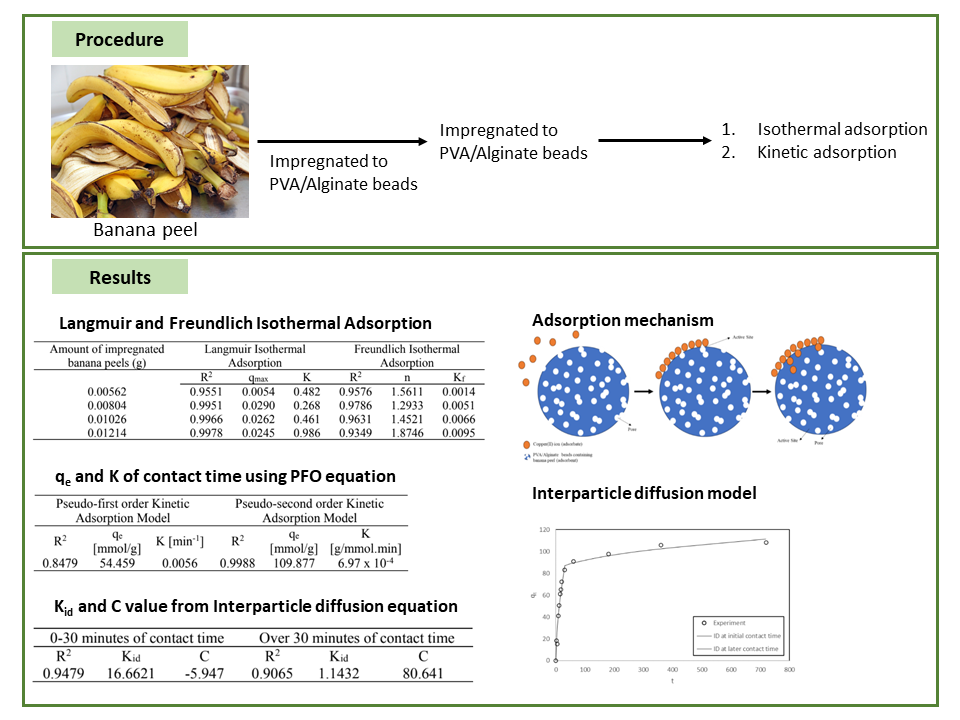pH Effect, Isothermal Adsorption, and Adsorption Kinetic Study of Copper(II) Ion into PVA/Alginate Beads Containing Banana Peels
Abstract

Banana peels have been widely used as a biosorbent for metal ion adsorption. However, the small size of banana peels as a biosorbent leads to difficulty in the separation process of banana peels from the aqueous solution. Thus, the banana peels were impregnated into PVA/Alginate beads to increase the biosorbent size using the (W/O) emulsion process. Various amounts of banana peels were impregnated into beads. The obtained beads were used to adsorb copper(II) ions from aqueous solutions. The result shows that beads could extract the copper(II) ion from an aqueous solution containing 0.7875 ppm copper(II) ion at pH 4 with the quantity of extraction was 0.729 mmol/g. The effect of contact time and initial concentration indicates that the adsorption process of copper(II) ion from aqueous solution using beads follows the Langmuir isothermal adsorption and the adsorption kinetic follows the pseudo-second-order equation. Hence, the adsorption mechanism follows a chemisorption process with monolayer formation on the PVA/Alginate containing banana peels. Further investigation was carried out and found that the surface reaction and film diffusion occurred at initial stage of contact time, adsorptive diffusion through pores occurred at the later stage.
References
[1] Akpomie, K. G., & Conradie, J., Environ. Chem. Lett., 2020, 18, 1085-1112.
[2] Fabre, E., Lopes, C. B., Vale, C., Pereira, E., & Silva, C. M., Sci. Total Environ., 2020, 709, 135883.
[3] Zango, Z. U., Am. J. Mater. Sci., 2018, 8(2), 32-38.
[4] Yaqub, A., Ajab, H., Almas, A., Syed, S.M., Azam, A., Khan, M.I., Awais, M., Muhammad, I., Galal, A.M. and Alshahrani, M.Y., Biomass Convers. Biorefin., 2022, 12(5), pp.1787-1802.
[5] Inda, N.I., Satrimafitrah, P., Aprilia, N.F., Yunia, D.D., Pato, V., Rohim, A., Ramadhani, S.A. and Shiomori, K., AIP Conference Proceedings, 2023, 2719 (1), AIP Publishing.
[6] Prakash, J., Kumar, T. S., Venkataprasanna, K. S., Niranjan, R., Kaushik, M., Samal, D. B., & Venkatasubbu, G. D., Appl. Surf. Sci., 2019, 495, 143543.
[7] Rezagholizade-shirvan, A., Najafi, M. F., Behmadi, H., & Masrournia, M., Inorg. Chem. Commun., 2022, 145, 110022.
[8] Khalid, I., Ahmad, M., Minhas, M. U., & Barkat, K., Polym. Bull., 2018, 75, 1075-1099.
[9] Michael, M., Lady, J., & Prasetyanto, E. A., AIP Conference Proceedings, 2020, 2237, (1). AIP Publishing.
[10] Basu, H., Saha, S., Pimple, M. V., & Singhal, R. K., J. Environ. Chem. Eng., 2018, 6(4), 4399-4407.
[11] Rahman, N. A., & Wilfred, C. D., J. Phys.: Conf. Series, 2018, 1123(1), 012067, IOP Publishing.
[12] Te Chuan, L., AN, A. A., Manap, N., Abdullah, H. Z., & Idris, M. I., Int. J. Integr. Eng., 2018, 10(9), 43-47.
[13] Majidnia, Z., & Idris, A., Chem. Eng. J., 2015, 262, 372-382.
[14] Zhang, X., Yan, L., Li, J., & Yu, H., J. Colloid Interface Sci., 2020, 562, 149-158.
[15] Mo, Z., Zhang, H., Shahab, A., Chen, J., & Huang, C., J. Taiwan Inst. Chem. Eng., 2023, 146, 104778.
[16] Nunez-Gomez, D., Rodrigues, C., Lapolli, F. R., & Lobo-Recio, M. A., J. Environ. Chem. Eng., 2019, 7(1), 102787.
[17] Malima, N. M., Owonubi, S. J., Lugwisha, E. H., & Mwakaboko, A. S., Int. J. Environ. Sci. Technol., 2021, 18, 3153-3168.
[18] Inda, N. I., Satrimafitrah, P., Aprilia, N. F., Yunia, D. D., Pato, V., Rohim, A., Ramadhani, S. A., & Shiomori, K., AIP Conference Proceedings, 2023, 2719(1). AIP Publishing.
[19] Yuh-Shan, H., Scientometrics, 2004, 59(1), 171-177.
[20] Ho, Y. S., J. Hazard. Mater., 2006, 136(3), 681-689.
[21] Weber Jr, W. J., & Morris, J. C., J. Sanit. Eng. Div., 1963, 89(2), 31-59.
[22] Kalam, S., Abu-Khamsin, S. A., Kamal, M. S., & Patil, S., ACS Omega, 2021, 6(48), 32342-32348.
[23] Ezzati, R., Chem. Eng. J., 2020, 392, 123705.
[24] Mckay, G., & Allen, S. J., Can. J. Chem. Eng., 1980, 58(4), 521-526.
[25] Ho, Y. S., & McKay, G., Chem. Eng. J., 1998, 70(2), 115-124.
[26] Gerente, C., Lee, V. K. C., Cloirec, P. L., & McKay, G., Crit. Rev. Environ. Sci. Technol., 2007, 37(1), 41-127.
[27] Rudzinski, W., & Plazinski, W., Langmuir, 2008, 24(13), 6738-6744.
[28] Zaini, H. M., Roslan, J., Saallah, S., Munsu, E., Sulaiman, N. S., & Pindi, W., J. Funct. Foods, 2022, 92, 105054.
[29] Ghosal, P.S., & Gupta, A.K., J. Mol. Liq., 2017, 225,137-146.
[30] Vimonses, V., Lei, S., Jin, B., Chow, C.W., & Saint, C., Chem. Eng. J., 2009, 148(2-3), 354-364.
[31] Auta, M., & Hameed, B.H., Chem. Eng. J., 2012, 198, 219-227.
Refbacks
- There are currently no refbacks.

This work is licensed under a Creative Commons Attribution-NonCommercial 4.0 International License.








